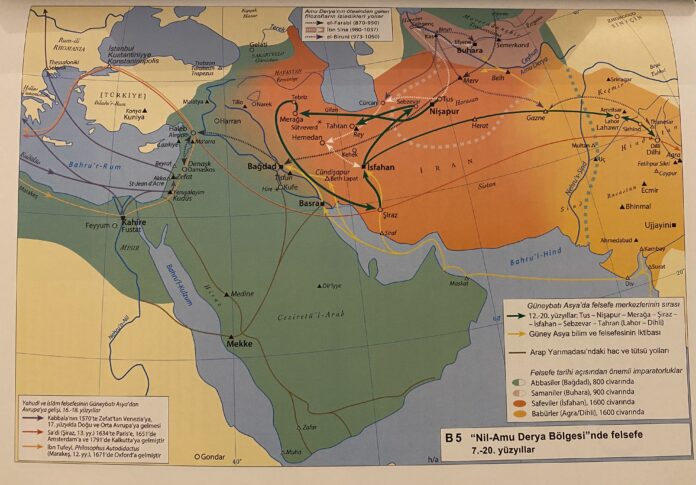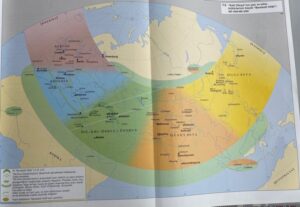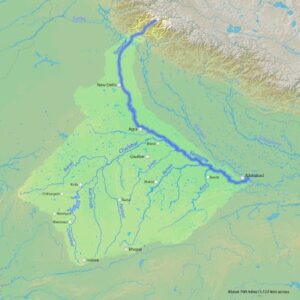The region between the Nile and the Amu Darya (Source: Atlas of Philosophy, Elmar Holenstein)
In the first volume of Levendname poems published in 2022, poems were expressed on a ground covering the continents of Europe, Asia and Africa, including more than four hundred place names based on the geographies of Turkey & Turkestan . In fact, the poems we designed as the second volume, which have my footprints, whose air I breathe, from the heart’s eye of the Turk, from the pen of the word, covering the Indian continent, Iran and Egypt, were written in 2019 but were not published. The region in question, which covers the continents of Asia and Africa, which we can call Afrasia , is a triangle-shaped image of the basic pillars of the transitional continental integrity that covers the oldest civilizations.
I visited each of these three countries in 2017, 2018, and 2019. In this way, I bring together the places that left their mark on me with the human landscapes and diversity I saw in these mystical geographies through poems.
In addition, from Turfan to Peç, from Kazan to Mecca , in the four directions of the compass, Turkish poetry left its mark with thousands of poems by more than two hundred poets for 1000 years. Therefore, as Turks, let us put into verse once again the geographies of the civilizations in question, where our traces and stamps are left.
I hope that it will be a start for us to poetize our geographies across the continents. In Mehmet Akif ‘s Safahat Poems book, we come across traces of different geographies and people in these geographies. However, in the period following Safahat, although the poems of poets from different geographies outside our country were brought into our language, these geographies were not poetized by Turkish poets.
The origin of words is sound and frequency. The ancestors left continents behind them and covered distances by talking. They thought that their grandchildren would write.
I also write my articles digitally on my website; it’s practical and easy.
- Levendname Poems: 2. Indian Travelogue
- Levendname Poems: 3. Travelogue to Iran
- Levendname Poems: 4. Travelogue of Egypt
Levendname; the code of the Great Mediterranean, which is the synthesis of the Great Asia where the ancestors galloped and the Mediterranean basin where they sailed to the seas. India, Iran and Egypt are the entrance gates and the heavenly levels. When the fascicles were completed; Sky. Earth. Person. Poetry Fasciles were actually written in 2019, but my mind was timed, so it reminded me on the first day of 2025 (9), “publish”. The symphony and oratorio of the blessed person in the width of time levels and grounds. It now begins to wait for its musicians towards the end of 2025; 9.
All three countries and civilizations continue to live together with deep traces in the minds of the Turks.
Nile-Amu Darya (Ceyhun)
Nile-Amu Darya (Ceyhun) region (green colored area)
Harran. Alexandria. Cairo. Damascus. Jerusalem. Baghdad. Babylon. Uruk. Basra. Isfahan. Shiraz. Nishapur. Bukhara. Kazan. Altai Mountains. Karabalgasun. Karakorum. Kucha. Turfan
Source: Atlas of Philosophy
In his book, Elmar Holstein, a historian of philosophy and author of the book Atlas of Philosophy, mentions the concept of the Nile-Yamuna Central Civilization Region . The main pillars of humanity’s civilizations rose in the region between the Nile in Egypt and the Yamuna River in the north-west of India.
Yamuna River (New Delhi, Agra cities)
I n d i a C o n t i n e n t
India is a border and neighbor of Turkestan in the north, in a geography where Turkish states were established in large numbers and in the countries of the Indian continent , the Urdu language spoken means Ordu language and is a predominantly Turkish language. On the other hand, Indian culture has taken place in our inscriptions with words and concepts since the inscription period and our teacher Osman Fikret Sertkaya examined these words one by one within the scope of an article.
Buddhism is a religion of the Indian continent that has had a great influence on the Turks . Especially the Ghaznavid, Timurid and Mughal empires are the state structures where Turkish culture has reached a synthesis with Indian culture . Urdu, Sanskrit and Turkish have all been instrumental in valuable works and poems because they have a poetic language structure.
While Turkey has a rectangular geography located on the horizontal plane, India has a triangular geography located on the vertical plane from north to south.
Of course, another issue that should not be overlooked here is related to the role played by the Indian continent rivers such as the Indus and the Ganges in the nourishment and development of this poetic culture. The settlements along the Indus River , starting from Lahore in the north and extending down to Karachi, and the collective culture that developed in New Delhi, Agra and the surrounding cities along the Yamuna River in the geography of India , continue to live today.
During the British colonial period, Indian poetry experienced a new era under the influence of Western literature. Rabindranath Tagore is one of the most important poets of this period. Tagore, who received the Nobel Prize in Literature, made significant contributions to world literature with his poems written in Bengali.
Rabindranath Tagore, Bengali polymath
Tagore with his son, two daughters and daughter-in-law Tagore and Gandhi, 1940 Bülent Ecevit, Turkish Prime Minister and Poet. Bülent ECEVİT (1925-2006)
The interaction between Indian and Turkish poetry has contributed to the formation of a rich literary heritage. This interaction has built an important bridge not only in terms of language and style but also in terms of thought and worldview. Both literatures have become richer and have acquired a universal character under the influence of the other.
I r a n
The Iranian languages, Soghud and Persian , have a long history of interaction with the Turkish language, and this interaction became even stronger first in the cities and geographies of Turkestan , and then when the Oghuz Turks moved south down the Seyhun River and entered the Iranian geography.
Especially in the Ghaznavid, Seljuk and Ottoman periods , Persian was a poetic language that sultans and poets admired. Persian is also related to Indian languages in origin. Turkish poets Mevlana, Fuzuli, Nizam-ı Ganjavi, Hacı Bektaş-ı Veli wrote poems in Persian. Shahnameh , the most important epic poem of the Iranians , was requested from Firdevsi by the Ghaznavid ruler Mahmud and the poet produced this work based on the struggles of Iran and Turan and these epic poems are chanted in the coffeehouses by the Iranian people.
The first Turkish inscription, the Buğut inscription, is written in Sogdian on one side and Sanskrit on the other . While the Turks used Arabic in science, they preferred Persian in art and religious terminology, and they advanced their cultural interactions with Iranian culture and language, especially in the Khorasan and Khwarezm regions . Since all corners of the Iranian geography were inhabited by Turks, symbiotic existence and interaction had penetrated deeply into both cultures.
Azeris, Turkmens, Qashgai Turks, Avshars, Qajars, Karapapaks, Kazakhs, Khalaj are the communities that keep Turkish culture alive in the Iranian geography. After Turkey, the country with the largest population of Turks is Iran.
In the Iran and Azerbaijan section of the map of Turkish poems written in 218 settlements outside Turkey , Azerbaijan is represented by 256 poets, Tabriz by 49 poets, Shamakhi by 30 poets, Shirvan (Khorasan) by 22 poets, Khorasan by 20 poets, Ganja by 18 poets, Nakhchivan by 17 poets, Baku by 16 poets, Karabakh by 15 poets, Shusha by 14 poets, Isfahan by 11 poets, Gazvin by 9 poets, Gazeh by 8 poets, Harezm by 8 poets, Hamadan by 8 poets, Hoy by 7 poets, Shamkir by 5 poets, Shiraz by 5 poets, Ardabil by 4 poets, Maragha by 3 poets, Ordubad by 3 poets, Serab by 3 poets, Hamedan by 2 poets, Revan by 2 poets, Halhal by 1 poet from Khorasan Bistam, Eher and Isferayin by 1 poet each.
During the transformation process, when the Turks had not settled down and had not yet acquired a state and cultural structure, the migrations that took place pushed the Turks and Iranians into an inseparable partnership.
After the Chinese, the Turks’ oldest neighbors were the Iranians.
If we consider that Iran was always ruled by a Turkish state from the Sassanids until the second quarter of the twentieth century and that more than half of the people living within the borders of today’s state were Turks, we understand that this relationship was not only very long, but also very deep.
Especially the Iranians and the Turks, who have been in the middle of the Turkish world for the last thousand years, have learned many things from each other during this long neighborly relationship. The interaction between the Iranian and Turkish civilizations is an interaction that can be rarely seen in the world.
As is known, the literature produced in Anatolia until the Tanzimat period, when we came under western influence, is called Divan literature. Firdevsi ‘s Shahnameh, written during the Ghaznavid period , also had a great influence on Turkish literature.
The concept of Divan literature includes literature founded on the aesthetic principles of Arabic and Persian literature, especially Persian literature in the broad sense. This literature, nourished by Islamic culture, took Iranian literature as an example during its foundation phase. This example continued to increase and decrease from time to time during the foundation period of the Ottoman Empire and later periods.
According to Ahmet Hamdi Tanpınar, the mythology of Divan poetry was directly taken from Shahnameh. From here, we see that the mythological background of Divan poetry is mainly Persian Mythology. The mythological source of Divan poetry is Iranian tradition. The mythological and historical figures here are mentioned frequently in Divan poetry. ( Source: History, Cultural and Eternal Interaction of Iranian and Turkish Civilizations Mehmet Mücahit ARVAS)
E g y p t
The most vital issue that the elites pondered over during the establishment of the Egyptian state in 1925 was whether the official language would be Turkish or Arabic.
The first modernization movements in the Ottoman Empire were also initiated in Egypt in the early 19th century. Tahtavi (1801-1873) compiled his observations in Paris, where he was in 1826-1831, in a book and discussed how the Western lifestyle should be transferred to Egypt.
Some of the Turkish Poets Influenced by Egypt
- Namık Kemal: Known as the poet of the homeland, Namık Kemal lived in Egypt during his exile. The beauties of the Nile River and the struggle of the Egyptian people are reflected in his poems.
- Mehmet Akif Ersoy: Islamic poet Mehmet Akif Ersoy also visited Egypt and wrote some poems under the influence of this country.
- Yahya Kemal Beyatlı: One of the important representatives of classical poetry, Yahya Kemal Beyatlı wrote many poems influenced by the historical and cultural richness of Egypt.
One issue that we should particularly mention here is the level of poetry reached by the Sumerian civilization, which came from Turkestan and settled in Mesopotamia via India, and the fact that the first love poem was written in the Sumerian civilization.
In this way, we can establish the connection between Turkestan, India, Sumer and Egypt . Because the Sumerian civilization is the most important of the main sources of the Egyptian civilization. In addition, the main indigenous people of Egypt, whom we call the Copts in Egypt, already have great wealth within the Christian church.
Among the geographies of India, Egypt and Iran that we have evaluated in this article , Egypt is the country that is most integrated with the Mediterranean, and in this sense, it is the most important country when we consider the Mediterranean’s environment that encourages interactions.
With its location at the intersection of Africa and Asia, Egypt thus embodies the cultural and artistic heritage of both continents. This geography is the Eastern Mediterranean region, known as the crucible of history, with Turkey in the north, Cyprus in the middle and Egypt in the south. This is a magical layering. With Turkey on its ceiling, Cyprus in the middle and Egypt at its base, this location is a poetic geography; it is also the apple of the eye of the sixth continent, the Mediterranean.
Six of our 11 poets born in Egypt were born in Cairo. Source: Turkish Literature Names Dictionary
As is known, every literary text is a kind of mirror of the period and environment in which it was created. In this sense, sometimes real, sometimes imaginary, various countries, cities, mountains, rivers and similar geographical elements are mentioned in the texts of classical Turkish poetry. One of the countries frequently encountered in the Divans is Egypt.
From the Tulunid period (868-905) until 1952, except for the Fatimid period, Egypt was ruled by people of Turkish origin or those raised in Turkish state culture.
Egypt, the cradle of one of the first civilizations in history, is a geographical region that the Turks have had relations with since ancient times. It came under Ottoman rule during the time of Yavuz Sultan Selim (in 1517) and thus began to be governed from Istanbul. After this date, relations between Anatolia, Istanbul and Egypt gained a different dimension; many Ottoman intellectuals began to visit this country for administrative, religious, political and social reasons.
In this context, many Ottoman poets went to Egypt for the purpose of studying, becoming governors, judges, clerks, traveling or for other reasons; some even preferred to live there. Indeed, the Gülşenî and Mevlevi lodges established by the Turks in Egypt created long-term and very important religious and literary circles there.
Conclusion
The British Empire , which tore its arch-rival Ottoman Turkish Empire to pieces and disintegrated it, and took control of countries such as Iran, India and Egypt , where Turks lived, due to the strategic raw materials of the time, be it cotton or oil, began to share the same fate from the beginning of the 21st century onwards.
The region described as the Middle East was initially India, which was ruled by the British. Later, the region shifted to the oil geography to the west of India, and the Arab lands were also included in the term Middle East.
The term Greater Middle East, which was first used in literature in 1943 after the Second World War, was now used by its cousin, the United States, to refer to a wide region starting from Morocco and extending into Central Asia.
These geographies where civilization was born were plundered starting from the end of the 19th century, and in the 21st century, there is hope for a rebirth in the geographies of Turkey, Turkestan, India, Iran and Egypt that we have mentioned here.
Poets, who were creators of magnificent poems with a rich cultural background, would be the preparers of revolutions.























